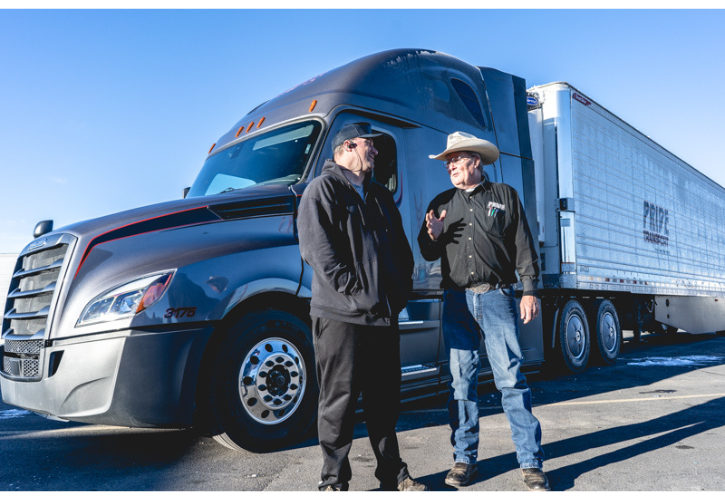by Pride Transport | Jun 01, 2023
You’ve probably seen three letters floating around a lot in the world of trucking: DOT. In an industry rife with acronyms, this is the most important one to know, since all drivers will come across it quite a bit.
Quite simply, DOT stands for Department of Transportation. The DOT aims to keep travel within the United States a safe experience. The DOT has many branches and covers all different types of transportation, but their mission is all-encompassing: “To deliver the world’s leading transportation system, serving the American people and economy through the safe, efficient, sustainable, and equitable movement of people and goods.”
Keep reading to learn more about the DOT and how the organization establishes and maintains compliance regulations.
An Overview of the DOT
Founded by Congress in October 1966 and in continuous operation since 1967, the DOT is led by the Secretary of Transportation, who is appointed by and advises the President on all federal transportation programs. The DOT has an Office of the Inspector General that audits each of the DOT’s operating administrations to make sure they’re operating efficiently and preventing fraud and waste. These programs include:
- Federal Aviation Administration
- Federal Railroad Administration
- Great Lakes St. Lawrence Seaway Development Corporation
- Federal Transit Administration
- Maritime Administration
There are also many agencies and administrations that specifically regulate the trucking industry.
- Federal Motor Carrier Safety Administration (FMCSA): The FMCSA is probably the organization you’ll encounter most as a truck driver. Since its creation in 2000, its mission has been to prevent commercial motor vehicle-related deaths and injuries. It regulates motor carriers and educates drivers on safe driving environments.
- Federal Highway Administration (FHWA): The FHWA maintains our infrastructure and makes sure U.S. roadways are safe and using cutting-edge technology.
- Pipeline and Hazardous Materials Safety Administration (PHMSA): The PHMSA gets involved whenever energy or hazardous materials are being transported. It regulates the transport of (and offers permits for drivers carrying) waste or potentially dangerous products.
Each bureau is managed independently, but they’re all expected to uphold the DOT’s standards of equity, sustainability, and, most importantly, safety.
DOT Regulations and Safety Standards
The DOT touches just about every part of the trucking industry, from the materials we transport, the roads we drive on, and the drivers behind the wheel. Because of this, staying in compliance with all of their rules and regulations is important if drivers and their company operators want to stay in good standing and continue providing their services.
Most of these regulations deal with the safety of drivers — both of trucks and of other cars on the road — though some rules are in place to maintain environmental safety. Compliance rules are typically split into two groups: rules for carriers and rules for drivers.
Company Compliance
To be DOT compliant, trucking companies must comply with many regulations and requirements. Not only are they responsible for helping their drivers maintain compliance, but they must keep their equipment up to par, too.
The FMCSA carefully maintains company safety and fitness electronic records so it can measure everything from vehicle inspections to crash reports and make sure that every carrier has proper operating authority.
Collecting data like this is crucial for companies who want to be transparent about how well they are complying (or failing to comply) with DOT regulations. In fact, there are many digital safety management systems available that can help carriers see summaries of any reviews or enforcement actions they might need to keep track of to troubleshoot more efficiently.
Consequences of non-compliance can include fines and penalties. If a carrier fails to adhere to regulations enough times, they might even risk being put out of business.
Driver Compliance
Remaining in DOT compliance is especially important for truck drivers. There are strict rules and high standards in place to keep their safety, as well as the safety of other drivers they encounter out on the road, paramount.
The following areas are monitored closely by the organization:
- Commercial Driver’s License Requirements: The commercial driver’s license, or CDL, program tests drivers’ knowledge and operating abilities before permitting them to get behind the wheel of a truck. The program also ensures that drivers operating a truck with multiple trailers, a tank, or hazardous materials are properly trained to handle a potential issue and physically prepared with protective garments.
- Hours of Service Limitations: The FMCSA’s Hours of Service, or HOS, limitations refer to the amount of time drivers are allowed to be on duty. These are in place to make sure that drivers are awake and alert when they’re behind the wheel, which helps to minimize the risk of them falling asleep behind the wheel.
- Drug and Alcohol Testing: This (thankfully!) isn’t unique to truck driving! The DOT prohibits any driver from operating their vehicle while under the influence of drugs or alcohol and asks motor carriers to test their employees.
- Medical Requirements: The FMCSA has a Medical Program Division that sets standards for the physical and mental health of drivers to ensure their fitness for vehicle operation.
Consequences of non-compliance for truck drivers can include loss of driving privileges or disqualification from employment. Drivers who are caught operating a vehicle under the influence might be asked to attend a rehabilitation program. In worst-case scenarios, consequences of unsafe driving can include injury or death. 
Resources for DOT Compliance
There are many resources for trucking industry owners and operators to check their compliance. Staying up-to-date on industry rules and regulations helps everyone maintain their own safety and keeps standards high so accidents are less likely to happen.
To stay abreast of this landscape’s latest news and requirements, check out the FMCSA Regulations page, which has compiled relevant laws in the U.S. Code of Federal Regulations. These are industry-wide standards and adhere to every U.S. trucking industry employee and contractor. There are also sites like U.S. Compliance Services that summarize many of the important rules in the business.
You can also check your state’s DOT website for any state-specific rules that might apply in the places you’re driving.
Pride Takes Compliance Seriously
Just like the DOT, Pride puts safety first. We strive to have as many drivers reach a goal of driving one million miles, but we put an extra spin on it: We want to help our employees make every one of those miles a safe one.
The first of our core values is to be safety-minded, and we also encourage our drivers to be knowledgeable, hard-working, friendly, approachable, and to always do the right thing. We take pride in how we uphold our own standards and the DOT’s and are eager to help you make sure your career stays in compliance, too.
To learn more about what roles we’re hiring for, check out on our website.
